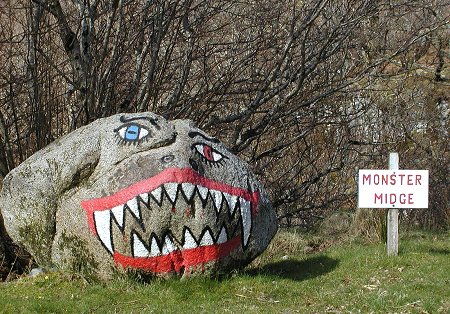| This Week’s Topic… | |||

Best viewed in
|
Scottish Midges
To avoid midges, it helps to know a little about their likes and dislikes. They like the cool indirect light of dawn and dusk, and dislike direct strong sunlight. They like damp conditions and dislike dry conditions. And they like still air and dislike anything above a fairly gentle breeze. All this tends to mean that midges are less common the middle of the day than in the mornings and evenings; that they are rarer on exposed hills than in sheltered valleys; and that the can be fond of woodland and forest areas. Finally, it is worth knowing that midges prefer dark colored clothing to light. It also helps to have an insect-repellant available. Most common are a range of different brands containing varying concentrations of a chemical called DEET (di-ethyl toluamide). Another chemical commonly used is DMP (dimethyl phthalate). A range of more natural (but usually less effective) alternatives are available including citronella and eucalyptus oils. Some also swear by the midge-repellant effects of Avon's Skin So Soft Body Oil, available as a spray. And you will also find netting midge hoods on sale in many outlets across the Highlands and Islands. It is worth keeping midges in perspective. They've been a part of life in the Highlands for centuries, and are only likely to depart if the climate changes so much that the country itself becomes a radically different place. And it's the country you come to the Highlands to see. Also bear in mind that the midges serve a useful purpose in controlling the role and impact of man in Scotland. Without them Scotland would be a different and a lesser place... |
||
